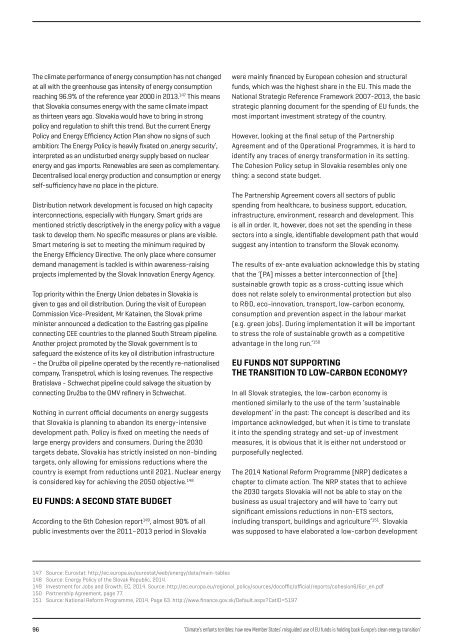ENFANTS TERRIBLES
enfants-terribles
enfants-terribles
You also want an ePaper? Increase the reach of your titles
YUMPU automatically turns print PDFs into web optimized ePapers that Google loves.
The climate performance of energy consumption has not changed<br />
at all with the greenhouse gas intensity of energy consumption<br />
reaching 96.9% of the reference year 2000 in 2013. 147 This means<br />
that Slovakia consumes energy with the same climate impact<br />
as thirteen years ago. Slovakia would have to bring in strong<br />
policy and regulation to shift this trend. But the current Energy<br />
Policy and Energy Efficiency Action Plan show no signs of such<br />
ambition: The Energy Policy is heavily fixated on ‚energy security’,<br />
interpreted as an undisturbed energy supply based on nuclear<br />
energy and gas imports. Renewables are seen as complementary.<br />
Decentralised local energy production and consumption or energy<br />
self-sufficiency have no place in the picture.<br />
Distribution network development is focused on high capacity<br />
interconnections, especially with Hungary. Smart grids are<br />
mentioned strictly descriptively in the energy policy with a vague<br />
task to develop them. No specific measures or plans are visible.<br />
Smart metering is set to meeting the minimum required by<br />
the Energy Efficiency Directive. The only place where consumer<br />
demand management is tackled is within awareness-raising<br />
projects implemented by the Slovak Innovation Energy Agency.<br />
Top priority within the Energy Union debates in Slovakia is<br />
given to gas and oil distribution. During the visit of European<br />
Commission Vice-President, Mr Katainen, the Slovak prime<br />
minister announced a dedication to the Eastring gas pipeline<br />
connecting CEE countries to the planned South Stream pipeline.<br />
Another project promoted by the Slovak government is to<br />
safeguard the existence of its key oil distribution infrastructure<br />
– the Družba oil pipeline operated by the recently re-nationalised<br />
company, Transpetrol, which is losing revenues. The respective<br />
Bratislava - Schwechat pipeline could salvage the situation by<br />
connecting Družba to the OMV refinery in Schwechat.<br />
Nothing in current official documents on energy suggests<br />
that Slovakia is planning to abandon its energy-intensive<br />
development path. Policy is fixed on meeting the needs of<br />
large energy providers and consumers. During the 2030<br />
targets debate, Slovakia has strictly insisted on non-binding<br />
targets, only allowing for emissions reductions where the<br />
country is exempt from reductions until 2021. Nuclear energy<br />
is considered key for achieving the 2050 objective. 148<br />
EU FUNDS: A SECOND STATE BUDGET<br />
According to the 6th Cohesion report 149 , almost 90% of all<br />
public investments over the 2011–2013 period in Slovakia<br />
were mainly financed by European cohesion and structural<br />
funds, which was the highest share in the EU. This made the<br />
National Strategic Reference Framework 2007-2013, the basic<br />
strategic planning document for the spending of EU funds, the<br />
most important investment strategy of the country.<br />
However, looking at the final setup of the Partnership<br />
Agreement and of the Operational Programmes, it is hard to<br />
identify any traces of energy transformation in its setting.<br />
The Cohesion Policy setup in Slovakia resembles only one<br />
thing: a second state budget.<br />
The Partnership Agreement covers all sectors of public<br />
spending from healthcare, to business support, education,<br />
infrastructure, environment, research and development. This<br />
is all in order. It, however, does not set the spending in these<br />
sectors into a single, identifiable development path that would<br />
suggest any intention to transform the Slovak economy.<br />
The results of ex-ante evaluation acknowledge this by stating<br />
that the ‘[PA] misses a better interconnection of [the]<br />
sustainable growth topic as a cross-cutting issue which<br />
does not relate solely to environmental protection but also<br />
to R&D, eco-innovation, transport, low-carbon economy,<br />
consumption and prevention aspect in the labour market<br />
(e.g. green jobs). During implementation it will be important<br />
to stress the role of sustainable growth as a competitive<br />
advantage in the long run.’ 150<br />
EU FUNDS NOT SUPPORTING<br />
THE TRANSITION TO LOW-CARBON ECONOMY?<br />
In all Slovak strategies, the low-carbon economy is<br />
mentioned similarly to the use of the term ‘sustainable<br />
development’ in the past: The concept is described and its<br />
importance acknowledged, but when it is time to translate<br />
it into the spending strategy and set-up of investment<br />
measures, it is obvious that it is either not understood or<br />
purposefully neglected.<br />
The 2014 National Reform Programme (NRP) dedicates a<br />
chapter to climate action. The NRP states that to achieve<br />
the 2030 targets Slovakia will not be able to stay on the<br />
business as usual trajectory and will have to ‘carry out<br />
significant emissions reductions in non-ETS sectors,<br />
including transport, buildings and agriculture’ 151 . Slovakia<br />
was supposed to have elaborated a low-carbon development<br />
147<br />
148<br />
149<br />
150<br />
151<br />
Source: Eurostat: http://ec.europa.eu/eurostat/web/energy/data/main-tables<br />
Source: Energy Policy of the Slovak Republic, 2014.<br />
Investment for Jobs and Growth. EC, 2014. Source: http://ec.europa.eu/regional_policy/sources/docoffic/official/reports/cohesion6/6cr_en.pdf<br />
Partnership Agreement, page 77.<br />
Source: National Reform Programme, 2014. Page 63. http://www.finance.gov.sk/Default.aspx?CatID=5197<br />
96<br />
‘Climate’s enfants terribles: how new Member States’ misguided use of EU funds is holding back Europe’s clean energy transition’


